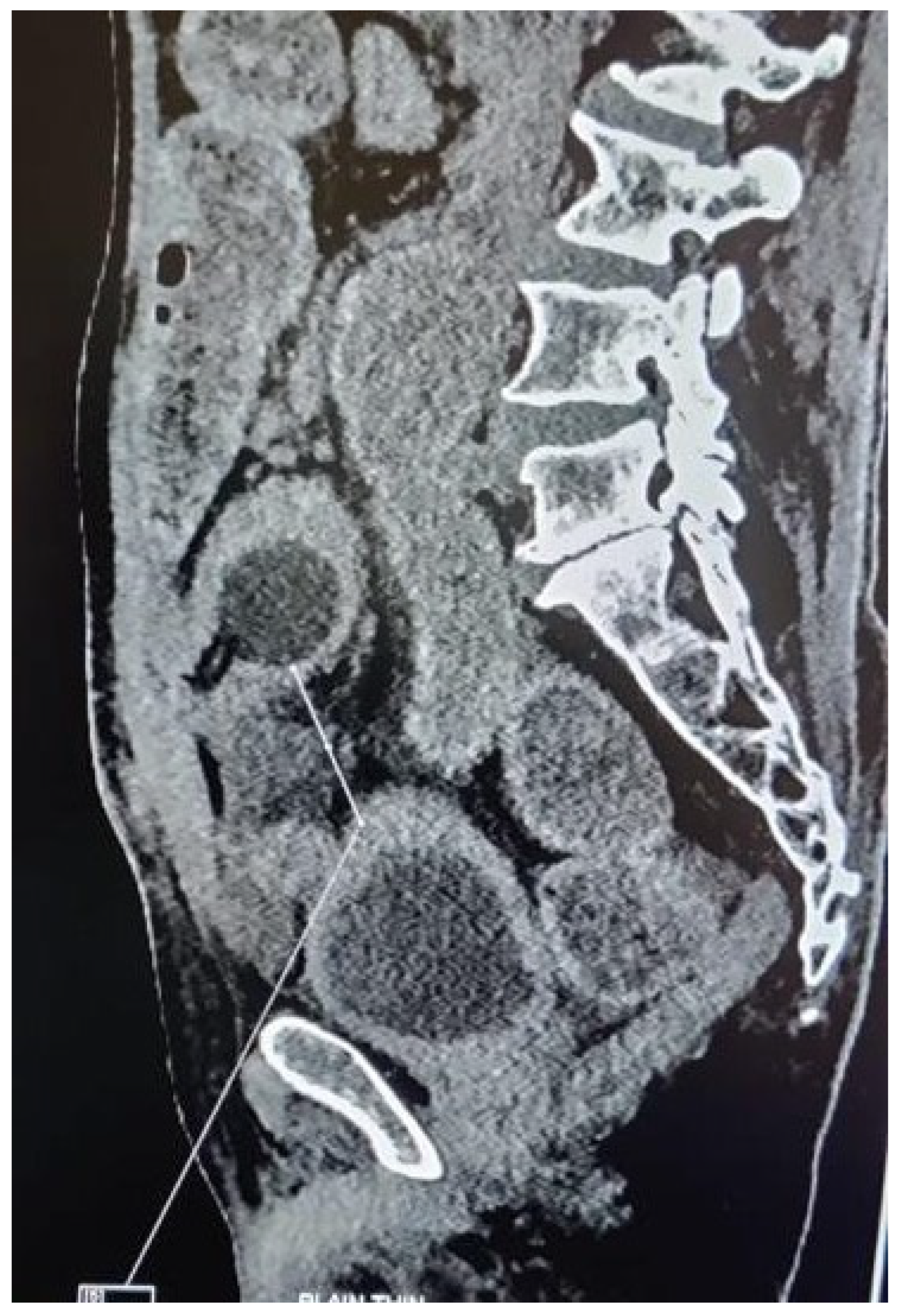Iatrogenic Small Intestine Perforation During Suprapubic Catheter Change
- The patient should be placed in the supine position, and the area from the umbilicus to the midthigh should be adequately exposed and cleaned.
- The bladder should be filled with approximately 250 mL through the existing catheter in order to distend the bladder and push the anterior bladder against the anterior abdominal wall.
- During withdrawal of the previous catheter, its length and direction of entry into the bladder should be noted, and the insertion of the new catheter within the tract should be in the same direction and up to approximately same length.
- The free flow of urine should be confirmed after the new suprapubic catheter insertion. The patient should be kept under observation for about 30 min after the suprapubic catheter exchange to confirm continuous drainage. There should be no pain during or after the catheter exchange.
Author Contributions
Funding
Institutional Review Board Statement
Informed Consent Statement
Data Availability Statement
Conflicts of Interest
References
- Kalpande, S.; Saravanan, P.R.; Saravanan, K. Study of factors influencing the encrustation of indwelling catheters: Prospective case series. Afr. J. Urol. 2021, 27, 50. [Google Scholar] [CrossRef]
- Jane Hall, S.; Harrison, S.; Harding, C.; Reid, S.; Parkinson, R. British Association of Urological Surgeons suprapubic catheter practice guidelines—Revised. BJU Int. 2020, 126, 416–422. [Google Scholar] [CrossRef] [PubMed]
- Oyortey, M.A.; Essoun, S.A.; Ali, M.A.; Abdul-Rahman, M.; Welbeck, J.; Dakubo, J.C.B.; Mensah, J.E. Safe duration of silicon catheter replacement in urological patients. Ghana. Med. J. 2023, 57, 66–74. [Google Scholar] [CrossRef] [PubMed] [PubMed Central]
- Ahluwalia, R.S.; Johal, N.; Kouriefs, C.; Kooiman, G.; Montgomery, B.S.I.; Plail, R.O. The surgical risk of Suprapubic catheter insertion and long-term sequelae. Ann. R. Coll. Surg. Engl. 2006, 88, 210–213. [Google Scholar] [CrossRef] [PubMed]
- Sheriff, M.K.M.; Foley, S.; McFarlane, J.; Nauth-Misir, R.; Craggs, M.; Shah, P.J.R. Long-term suprapubic catheterisation: Clinical outcome and satisfaction survey. Spinal Cord. 1998, 36, 171–176. Available online: https://pubmed.ncbi.nlm.nih.gov/9554016/ (accessed on 7 December 2023). [CrossRef] [PubMed]
- Cundiff, G.; Bent, A.E. Suprapubic catheterization complicated by bowel perforation. Int. Urogynecol J. Pelvic Floor. Dysfunct. 1995, 6, 110–113. [Google Scholar] [CrossRef]
- Wu, C.-C.; Su, C.-T.; Lin, A.C.-M. Terminal ileum perforation from a misplaced percutaneous suprapubic cystostomy. Eur. J. Emerg. Med. 2007, 14, 92–93. [Google Scholar] [CrossRef] [PubMed]
- Mongiu, A.K.; Helfand, B.T.; Kielb, S.J. Small bowel perforation during suprapubic tube exchange. Can. J. Urol. 2009, 16, 4519–4521. [Google Scholar] [PubMed]
- Witham, M.D.; Martindale, A.D. Occult transfixation of the sigmoid colon by suprapubic catheter. Age Ageing 2002, 31, 407–408. [Google Scholar] [CrossRef] [PubMed]


Disclaimer/Publisher’s Note: The statements, opinions and data contained in all publications are solely those of the individual author(s) and contributor(s) and not of MDPI and/or the editor(s). MDPI and/or the editor(s) disclaim responsibility for any injury to people or property resulting from any ideas, methods, instructions or products referred to in the content. |
© 2025 by the authors. Published by MDPI on behalf of the Société Internationale d’Urologie. Licensee MDPI, Basel, Switzerland. This article is an open access article distributed under the terms and conditions of the Creative Commons Attribution (CC BY) license (https://creativecommons.org/licenses/by/4.0/).
Share and Cite
Kumar, N.; Rizwi, K.; Singh, S.; Kumar, S. Iatrogenic Small Intestine Perforation During Suprapubic Catheter Change. Soc. Int. Urol. J. 2025, 6, 1. https://doi.org/10.3390/siuj6010001
Kumar N, Rizwi K, Singh S, Kumar S. Iatrogenic Small Intestine Perforation During Suprapubic Catheter Change. Société Internationale d’Urologie Journal. 2025; 6(1):1. https://doi.org/10.3390/siuj6010001
Chicago/Turabian StyleKumar, Naveen, Kashif Rizwi, Saket Singh, and Shashikant Kumar. 2025. "Iatrogenic Small Intestine Perforation During Suprapubic Catheter Change" Société Internationale d’Urologie Journal 6, no. 1: 1. https://doi.org/10.3390/siuj6010001
APA StyleKumar, N., Rizwi, K., Singh, S., & Kumar, S. (2025). Iatrogenic Small Intestine Perforation During Suprapubic Catheter Change. Société Internationale d’Urologie Journal, 6(1), 1. https://doi.org/10.3390/siuj6010001




